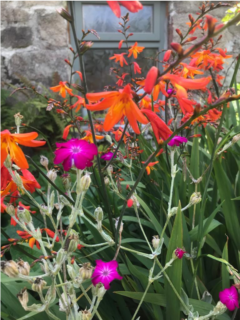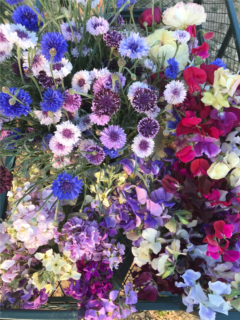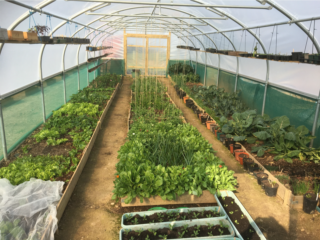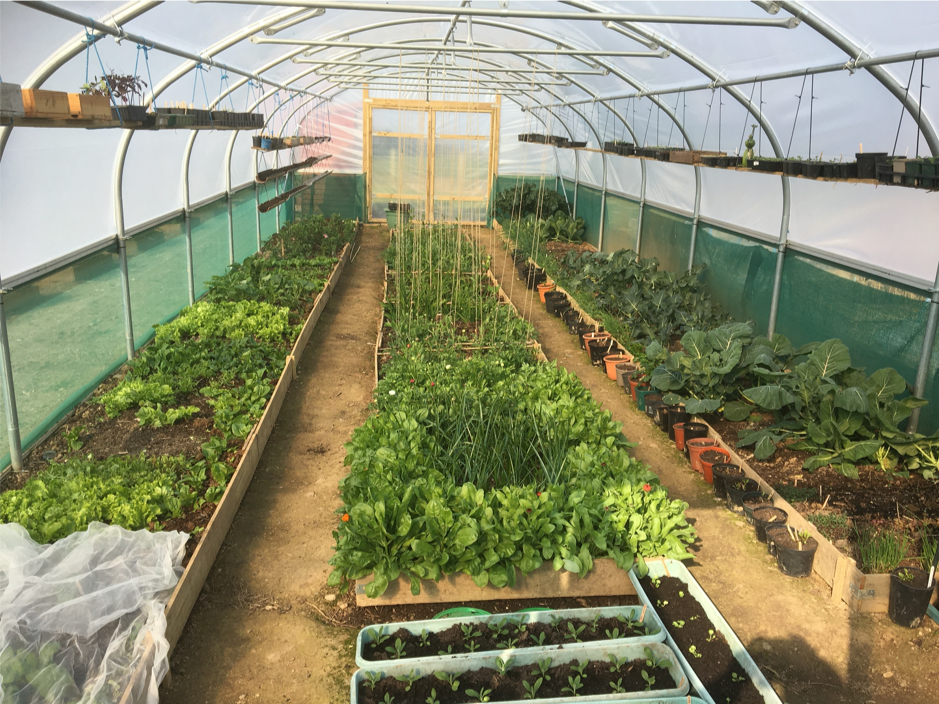Roseland Online, April 2021
Apart from some unpleasant winds, it hasn’t been a bad start to the year, and in some respects, our gardens are looking very good. I think the spring flowers – daffodils, camellias, primrose, fritillaries, hellebores – are looking as good as I ever seen them this year, and that has certainly lifted my spirits in this rather uncomfortable period.
This is the time of year when I go into a bit of a flat spin because there is so much to be done, and being part of Calendra Collective, there is even more than usual. We are sowing flowers and vegetables like fury, and in most cases , we have been quite measured with the veg. However, I am guilty of getting a bit flip when I am broadcasting flower seed, and have been known to say a mental “sod it” and fling the rest of the packet in. Just don’t. I have just pricked out something in the region of 300 snapdragons, and even the most efficient of flower growers don’t need that many. It’s fine if you are brave enough to throw excess away, but I am not. Take a hint from me, and just sow what you need, plus 10% or so to allow for failure. You won’t regret it.
Now we have passed the equinox, the laws of gardening say you can now prune your summer- and autumn-flowering evergreen shrubs: pittosporum, griselinia, abelia, Portuguese or Cherry laurel, and photinia (Red Robin), for example, can be tidied up, or can be cut back hard if you want to reduce their size or reshape them and they will regrow quickly. Others such as holly and bay can also be cut hard, but are slower to regrow, so just bear that in mind. I have some shrubs where the leaves have nigh on vanished or crisped all over in the recent persistent easterlies. They will almost certainly reshoot, and soon, but I’ll have to tolerate them looking rubbish for this year. As always, hold off pruning if frost or strong winds from a cold direction are expected within a few days. It can still happen, even here.
Some more tender shrubby plants (euphorbia mellifera, buddleja and melianthus major, for example) can stand to be cut right down to the ground because they will reshoot from the base with lovely new stems. Just remember that everything you cut back hard should also get a feed, as you will be asking it to do an awful lot this year. A good liquid feed, a handful of fast-acting chicken manure, or blood fish and bone will do it.
But don’t, whatever you do, prune anything that is due to flower before midsummer (lilac, deutzia, spring and summer viburnums) , as you will lose the flowers for this year, or get a feeble late flowering in late summer. If you want to reduce their size, prune straight after flowering so that they get a chance to put on some new growth ready for next year’s flowering.
 If the weather is reasonable, the ground should be warming up nicely so now is a great time to get herbaceous perennials in the ground. These are plants which come back year after year; well, most do if they haven’t had to swim all winter, but they don’t go woody like a tree or shrub. These are great plants for adding colour to a garden; they come in all shapes and sizes and there is something for every garden position. If you have an area in your garden which is, perhaps, all spring-flowering, consider using perennials to give you later colour – for example, phlox for scent and summer colour, Japanese anemones for late summer colour, Michaelmas daisies for the autumn. At this time of year, they are often available in small pots which offer great value for money. If you can squeeze in more than one specimen, always plant in odd numbers. And it’s worth remembering that bigger clumps of fewer species will actually give you more impact.
If the weather is reasonable, the ground should be warming up nicely so now is a great time to get herbaceous perennials in the ground. These are plants which come back year after year; well, most do if they haven’t had to swim all winter, but they don’t go woody like a tree or shrub. These are great plants for adding colour to a garden; they come in all shapes and sizes and there is something for every garden position. If you have an area in your garden which is, perhaps, all spring-flowering, consider using perennials to give you later colour – for example, phlox for scent and summer colour, Japanese anemones for late summer colour, Michaelmas daisies for the autumn. At this time of year, they are often available in small pots which offer great value for money. If you can squeeze in more than one specimen, always plant in odd numbers. And it’s worth remembering that bigger clumps of fewer species will actually give you more impact.
Be warned though, it’s still quite chilly at night so plant out anything small with due care, as there is still the chance of a crispy white morning and anything tender really won’t like it. If you are able, keep your little plants under cover for a couple of weeks longer, then gradually harden them off, first during the day, and then day and night, and plant out when the little beauties have become more robust.
No Spring shows again this year, sadly, but nurseries and garden centres are full of lovely plants, and soon, you’ll be able to get a cup of tea, coffee and a bun at our local, Roseland Plant Centre, as Da Bara open Da Bara in the Garden there in just a few weeks. There goes my purse and my waistline again……
 For those of you with big spaces to fill, hardy annuals could be a possibility. A lot can be direct sown in the soil and left to get on with it; cornflowers, love in a mist and night-scented stocks are good reliable examples. If the more tender annuals float your boat, start them off either on a windowsill or in a greenhouse, or buy from Veryan shop over the coming weeks. Once they have germinated, prick them out into small pots, and grow them on. (Note my cautionary tale above though…) If you don’t have a greenhouse, a makeshift cold frame will give adequate shelter and fleece can be a life saver, literally! A little advice from someone who has learnt the hard way; if you start your bedding off a little later, they are easier to grow as it’s warmer, and will still be giving you a mass of colour until the first frosts. We’ve seen French lavender in full flower being offered for sale in March, and trust us, that’s not going to be looking amazing when you’re barbecuing in the summer.
For those of you with big spaces to fill, hardy annuals could be a possibility. A lot can be direct sown in the soil and left to get on with it; cornflowers, love in a mist and night-scented stocks are good reliable examples. If the more tender annuals float your boat, start them off either on a windowsill or in a greenhouse, or buy from Veryan shop over the coming weeks. Once they have germinated, prick them out into small pots, and grow them on. (Note my cautionary tale above though…) If you don’t have a greenhouse, a makeshift cold frame will give adequate shelter and fleece can be a life saver, literally! A little advice from someone who has learnt the hard way; if you start your bedding off a little later, they are easier to grow as it’s warmer, and will still be giving you a mass of colour until the first frosts. We’ve seen French lavender in full flower being offered for sale in March, and trust us, that’s not going to be looking amazing when you’re barbecuing in the summer.
As for the vegetable garden, it’s full steam ahead.
Keep courgettes, tomatoes, cucumbers, sweet corn and runner beans in the warmth for this month (above 12 degrees) , otherwise the cold will check them and they take an age to recover, if at all.
 Carrots, parsnips, spinach, turnips, peas etc can all be sown outside but if you don’t have the time or inclination, packs of small plants are readily available at Veryan Shop now and the variety will increase apace over the next few weeks . Plant yours in small batches and repeat a few weeks later so you have a continuous supply of wonderful home-grown veg. Once growing, don’t forget to feed them. We like to use a liquid seaweed feed when the plants are small, then move onto pelleted poultry manure (unless you have a greedy dog who eats it…ahem).
Carrots, parsnips, spinach, turnips, peas etc can all be sown outside but if you don’t have the time or inclination, packs of small plants are readily available at Veryan Shop now and the variety will increase apace over the next few weeks . Plant yours in small batches and repeat a few weeks later so you have a continuous supply of wonderful home-grown veg. Once growing, don’t forget to feed them. We like to use a liquid seaweed feed when the plants are small, then move onto pelleted poultry manure (unless you have a greedy dog who eats it…ahem).
Anyway, that’s enough reading. Get out there and start on your to do list!!
Helen Robins, Calendra Collective
calendracollective@outlook.com

